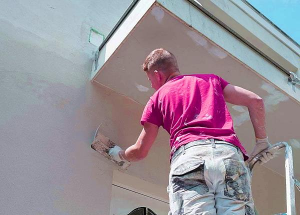Philadelphia Stucco Contractor is a skilled professionals who restore and enhance your home’s surface area. They provide high-quality workmanship that improves your home’s value and performance over time.
Choosing the right stucco contractor requires careful research and proper vetting. Checking a contractor’s portfolio and client references is an important first step.

Experienced contractors have superior supplier contacts, which can save you money on quality products. They are also familiar with local building codes and regulations, which streamlines the process for you.
Experience
Stucco contractors have years of industry experience under their belts, which can help ensure the job is completed correctly and promptly. This will prevent you from having to rework the job in the future due to poor workmanship, misapplication of materials, or other issues. Additionally, industry longevity is a good indication of customer satisfaction and professionalism. When selecting a stucco contractor, it is also important to review their portfolio and references. This will help you identify whether their work aligns with your vision and style preferences.
Obtaining detailed quotes from multiple contractors is a good way to compare pricing and services. This will allow you to choose a contractor who best fits your project needs and budget. It is essential to avoid a contractor who provides unusually low bids without a clear explanation, as this could indicate subpar materials or hidden costs.
A good stucco contractor will be able to provide you with a comprehensive warranty and service guarantee. This will give you peace of mind that the contractor stands behind their work and is committed to quality results. Ensure that you understand the terms of the warranty and any other details related to it before signing a contract.
Local stucco contractors have in-depth knowledge of the area’s specific building codes and regulations. They will be able to streamline the process of getting permits and inspections, which can save you time and hassle. They may also have established relationships with suppliers that can result in lower material prices, saving you money on your project. They are also familiar with the unique threats that stucco faces in your area, such as high moisture levels and pests.
License
Stucco is a unique construction material and requires specialized skills. Choosing the right stucco contractor is critical to your project’s success. It’s essential to find a skilled professional who can perform quality work at a fair price. The best way to do this is to ask targeted questions that will help you find the right candidate for your job.
First, look for a plastering contractor with years of experience in the industry. This will show that they have a proven track record of completing high-quality projects. They will also have the necessary tools and materials to finish the job quickly and efficiently.
Additionally, make sure to check whether the contractor is licensed in your state. Licensing is a key indicator of professionalism and ensures that the contractor adheres to industry standards. It’s also important to verify that they have insurance, which should cover liability and workers’ compensation in the event of an accident or injury.
Another important consideration is whether the contractor offers a warranty on their work. This will give you peace of mind that the work is of high-quality and will last for a specified time frame. Additionally, you should choose a contractor who provides maintenance services to keep your stucco looking its best.
When it comes to hiring a plastering or stucco contractor, you want to be sure that they are licensed and insured in your state. A license will demonstrate that they have passed a background check and have met minimum licensing requirements. You should also look for a plastering or stucco contractor with years of experience in the industry and a strong portfolio of completed projects. These indicators will help you determine if they are the right fit for your project.
Insurance
Stucco is a very delicate material that needs to be installed properly to prevent cracking and other damage. Improper installation can result in moisture trapping within walls, causing mold and mildew as well as rotted wood or termite infestation. Homeowners are often left paying for expensive repairs or even seeking help from their insurance companies. This is why hiring a stucco contractor with insurance and a portfolio of client references is so important.
Besides being licensed, a good plastering and stucco contractor will carry liability and workers’ compensation insurance. General liability insurance covers third-party property damage and bodily injury, while workers’ compensation covers employee work injuries. The ideal policy should also cover tools and equipment, as many contractors have a large amount of investment in their tool sets and can suffer a loss if they are stolen or damaged on the job.
Plastering and stucco contractors can often be found on construction sites where they are exposed to various risks. For instance, they are vulnerable to property damage from wind and rain that could erode the surface, as well as other weather events that can cause costly interruptions to work. Additionally, they are likely to need commercial auto insurance, as they will transport materials and equipment from their homes to job sites.
A reliable stucco and plastering contractor will offer business owners a comprehensive insurance package that includes professional liability, commercial auto, workers’ compensation, contractors tools and equipment and a Business Owners Policy (BOP). By working with a broker who has access to over 240+ carriers, they can find you the right policy to protect your company from any potential perils. They will also assist you in navigating the confusing world of insurance and offer advice to help reduce your premiums.
Portfolio
A stucco contractor’s portfolio is a critical tool for determining their suitability to work on your project. Look for a wide range of projects, including both new construction and repair. This will help you choose a contractor with the skills and experience to handle any challenges that might arise. A well-presented portfolio will also demonstrate their attention to detail and craftsmanship.
Stucco is a time-honored building material that has been adorning structures for centuries. It is a mixture of cement, lime, sand and water that creates an eye-catching, textured finish. In addition to protecting a home or commercial property from the elements, stucco adds character and charm. Its unique appearance is what sets it apart from other siding materials such as wood, vinyl and metal.
Choosing the right contractor is crucial to ensuring that your project is completed on time and within budget. Look for a contractor who has a strong reputation and excellent customer reviews. Additionally, choose a contractor who uses high-quality materials and modern techniques. This will ensure that your finished product is durable and aesthetically pleasing.
While stucco may seem like a simple application, it requires the expertise of a qualified contractor. A seasoned contractor will have an in-depth understanding of various architectural styles, as well as the ability to overcome any challenges specific to NYC’s dynamic urban environment.
A professional stucco contractor will have a wealth of experience in repairing and installing both traditional and EIFS (Exterior Insulation and Finishing Systems) stucco. EIFS is a synthetic type of stucco that provides more protection against moisture than traditional stucco. It is also more energy efficient, as it regulates temperatures and keeps a home or business cooler in the summer and warmer in the winter.
Warranties
Stucco repair contractors who offer warranties provide homeowners peace of mind and enhance resale value. Typically, these warranties cover both the material and labor for the duration of the warranty term. The warranties may also include other materials such as metallic mesh, paints, and primers. If the contractor does not offer any type of warranty, this may be an indication that they are using substandard materials or lack quality workmanship.
A stucco warranty can prevent moisture intrusion and mold issues that are often associated with the improper installation of stucco materials. Moisture issues can lead to mildew, rot, and other structural problems, which require extensive repairs to rectify. Having a stucco warranty can help you avoid the costly consequences of moisture damage, and ensure that your project is completed properly from start to finish.
Testimonials, references, and referrals are great ways to assess a stucco contractor’s level of skill and quality work. Look for these features on the contractor’s website or social media accounts to learn more about the positive experiences that other clients have had with the company.
A well-respected and reputable stucco contractor will have a large portfolio of past projects. Examine the images in this portfolio for consistent quality and attention to detail. Also, look for a finished product that is smooth and even with no cracks or uneven textures.
The MoistureFree Warranty provides a solution to the many problems that synthetic EIFS and hardcoat stucco homes face, including negative stigmas, reluctance by Realtors to sell these types of homes, and expensive moisture repairs. MoistureFree offers a low cost and simple process to obtain a warranty, and it covers all of the expenses related to moisture inspections and remediation for the duration of the warranty term.



